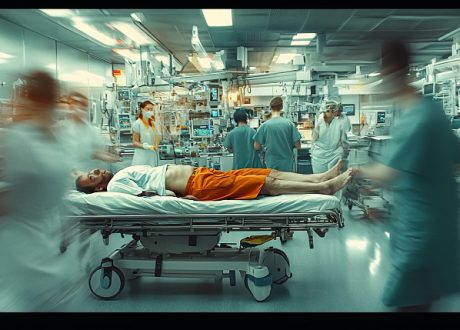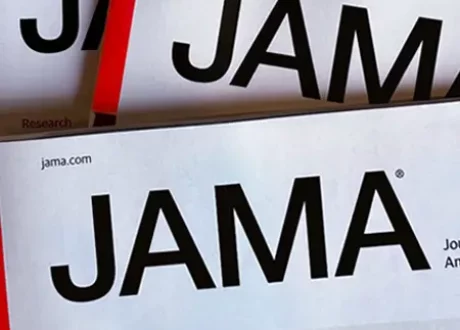Abstract 
Penetrating trauma of the aortic arch is relatively uncommon, even at busy trauma centers. Such an injury is challenging, especially in a “crashing” patient in whom emergency surgery is undertaken. When this scenario is coupled with an aortic arch abnormality, it may be infinitely more difficult to deal with, and the injury may prove non-salvageable. Bovine aortic arch abnormality occurs in approximately 25% of patients in our setting, according to existing literature. Hence, penetrating injury of a bovine aortic arch would be extremely rare. We present a patient who sustained a stab wound to a bovine arch, which proved non-salvageable because proximal and distal vascular control could not be provided without rendering the brain anoxic. We provide an overview of the bovine arch abnormality and a brief review of the management of aortic arch injuries.
1. Introduction
Penetrating trauma of the thoracic aorta is infrequent, almost always life-threatening, and carries a mortality rate as high as 92.3% [1]. Although endovascular techniques are increasingly used, operative intervention is often undertaken. The surgical principle of proximal and distal vascular control poses a challenge during emergency surgery on the aortic arch, but there are maneuvers that may be used to address this issue. However, when an injury to a bovine aortic arch (BAA) anomaly (Figure 1) occurs, it may be impossible to safely achieve proximal and distal vascular control without occluding both common carotid arteries and compromising cerebral perfusion. We present a patient who sustained an un-survivable penetrating injury of the aortic arch due to the presence of a BAA.
2. Case presentation
A 20-year-old male sustained an isolated zone 1 penetrating neck injury just to the right of the midline. The patient was initially taken to a local clinic by friends, where the wound was sutured and two liters of intravenous crystalloid were infused. He was referred by the clinic to our tertiary facility, arriving five hours later. During transit, he was hemodynamically stable, with blood pressure (BP) 123/58, heart rate (HR) 100, oxygen saturation (SpO2) 99% on room air, and temperature 37°C.
In our Emergency Department, examination and initial management followed standard Advanced Trauma Life Support® principles. The patient’s airway was patent and self-maintained, and lung fields were clear on auscultation. Heart rate ranged between 90 and 105 beats per minute, with BP 117/50 on the left arm and 100/58 on the right, giving a brachial–brachial index of 0.86. Both radial pulses were palpable and equal with 99% SpO2 on both hands. There was a three-centimeter supraclavicular stab wound at the right sternoclavicular junction. A non-pulsatile, non-expanding hematoma was beneath the wound, with no audible bruit. Extended focused assessment with sonography for trauma showed no evidence of hemothorax, pneumothorax, or pericardial fluid. A venous blood gas test result included pH 7.33, Base Excess 1.5 mEq/L, lactate 3.5 mmol/L, and hemoglobin 8.3 g/dL.
The patient went for an emergency computerized tomography with angiography (CTA) (Figures 2 and 3). As the CTA was nearing completion, the patient’s wound started bleeding profusely. Attempts at Foley’s catheter balloon tamponade failed to control the bleeding. External digital compression of the wound was maintained and the patient was taken immediately to the operating theater. There was no opportunity to review the CTA. Rapid sequence induction, emergency intubation, and resuscitation with permissive hypotension were administered while preparing for an emergency median sternotomy. Emergency thoracic surgery in our institution is undertaken by General and Trauma Surgeons in the main theater suites as we neither have hybrid theater capacity nor a cardiothoracic surgery service, and hence no access to cardiopulmonary bypass (CPB).
After splitting the sternum and opening the mediastinum, hemorrhage was controlled with direct pressure using a gauze swab while dissection was carried down to the point of bleeding, which then was digitally controlled. It was found that the patient had a congenital variation of the great vessels, a BAA. There was a near-total transection of the origin of the “bovine trunk” at the level of the aorta (Figure 4). Proximal and distal vascular control is imperative when repairing such an injury. A Satinsky clamp was applied to the aorta without occluding the arch. While it was technically possible to apply vascular clamps distally on the arch vessels to control back bleeding, this was not a feasible option in this patient. Due to this anatomical anomaly, obtaining distal vascular control would have meant occluding both common carotid arteries and the right subclavian artery. This would leave the brain with perfusion only from the left vertebral artery arising from the left subclavian artery. In this situation, the combination of the BAA and the location and severity of the injury rendered it a non-survivable scenario. The decision was therefore made to abandon the procedure, and the patient died on the operating table.
3. Discussion
The aortic arch and its branches are responsible for blood supply to the head, neck, and upper limbs. The typical pattern consists of three main branches—from right to left, these are the brachiocephalic trunk which gives rise to the right subclavian artery and right common carotid artery, the left common carotid artery, and the left subclavian artery. There are a number of congenital variations in aortic arch branching patterns—one being the BAA. In this variation, the aortic arch has only two branches: a common trunk giving rise to both the brachiocephalic trunk and left common carotid artery, with the left subclavian artery arising as the second branch (Figure 1). The BAA is the most common aortic arch variant within African and South American populations, with a prevalence of 26.8% and 24.2%, respectively, and is more prevalent than previously assumed [2]. Although generally asymptomatic, the BAA is known to pose a high risk for vascular complications such as cerebrovascular events and other problems after endovascular procedures [3]. There is limited literature available that relates specifically to the risks of BAA injuries in trauma; however, existing literature on aortic arch injuries describes varied mechanisms of injury, management strategies, and outcomes.
An autopsy study conducted in Greece showed the overall prevalence of thoracic aortic injuries was relatively low and a blunt mechanism was the predominant cause of injury [4]. These authors found that traumatic aortic injury was responsible for 12.7% of all injury-related fatalities and penetrating trauma was responsible for only 13.6% of those deaths. They also reported that the aortic arch and the ascending aorta were the most common sites of thoracic aortic injury following penetrating wounds, while the isthmus was most commonly involved in blunt injuries [4].
Other studies describe the successful management of thoracic aortic arch injuries. One such example describes a patient who sustained a through and through injury to the thoracic aorta by an airgun which was successfully repaired with the aid of deep hypothermic circulatory arrest (DHCA) as well as retrograde cerebral perfusion achieved with CPB. The advantages of DHCA and CPB include rapid aortic exposure, allowing for protection of cerebral perfusion [5]. The patient in our case report was potentially salvageable if CPB and DHCA had been available, but there would be a high risk of cerebrovascular brain damage. Unfortunately, our patient could not be transferred to a unit with these facilities because of his acute decompensation and need for emergency surgery.
In a case report by Ariaka et al., a patient presented with a ballpoint pen impaled in the neck with an aortic arch injury. The pen had a tamponading effect and allowed for isolation of the injury using a side-biting Satinsky clamp with subsequent primary repair [6]. In the current case report, it was not a problem applying a Satinsky clamp to the aortic arch for proximal control, but this was not physiologically feasible.
The mainstay of treatment for aortic arch injuries following penetrating trauma has traditionally been operative, but on rare occasions, these injuries have been managed conservatively. Conservative management is dependent on the site and severity of the injury and the hemodynamic status of the patient and demands a setting in which patients can be appropriately monitored and surveyed both during admission and at subsequent follow-ups after discharge [7].
This current case report highlights the potential challenges represented by anatomical variations of the aortic arch in a decompensating (“crashing”) trauma patient in whom preoperative CTA could not be reviewed and the anomaly only discovered at the time of surgical intervention. A practical takeaway from this case is that basic maneuvers such as Foley catheter balloon tamponade [8], digital compression, and permissive hypotension [9] can be used as a bridge to definitive intervention when faced with active bleeding.
Cordova et al. [10] describes graft repair of a traumatic innominate artery pseudoaneurysm in the setting of a bovine arch, but this injury was situated above the bifurcation of the bovine trunk and therefore cross-clamping was feasible. The emphasis in the current case report is that no form of cross-clamping was feasible without inducing immediate global brain ischemia. The injury of the bovine trunk was at its take-off from the aortic arch, and the transection was near-total. Hence, with no landing zone for a stent proximally, endovascular management would not have been feasible in this case either. Volpe et al. describe successful stenting of the innominate artery in the setting of a bovine arch but again the innominate artery distal to the bifurcation of the bovine trunk was involved, not the bovine trunk itself [11].
Gott et al. described a heparin-bonded shunt for off-pump use in excluding part of the aortic arch [12], and since then there have been a number of reports on the successful use of this technique and modifications thereof in treatment of aortic arch injuries [13]. A modification of this shunt described by Gelsomino et al., which has the ability to provide cerebral perfusion, may have offered a chance of survival to our patient, had it been available [14].
Although some aortic arch injuries may be survivable, overall mortality rate remains high. BAA anomalies are found in only a portion of the population—with injuries to such arches being extremely rare. Due to the associated implications of such a unique injury, BAA injuries, particularly those involving the bovine trunk, can be expected to be uniformly fatal in acutely decompensating patients who cannot undergo preoperative imaging and who are treated at units without the availability of a modified Gott shunt and without the capacity to perform DHCA and CPB.













